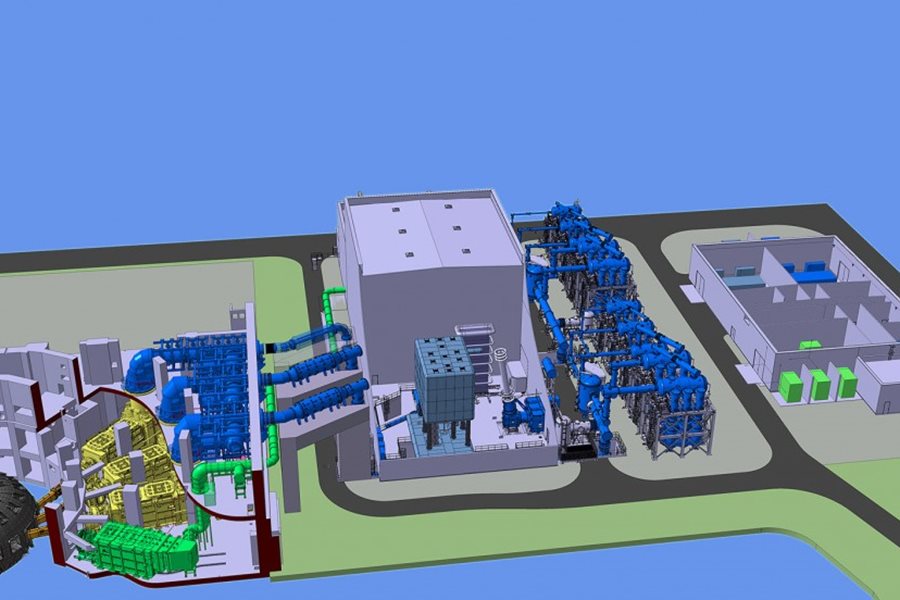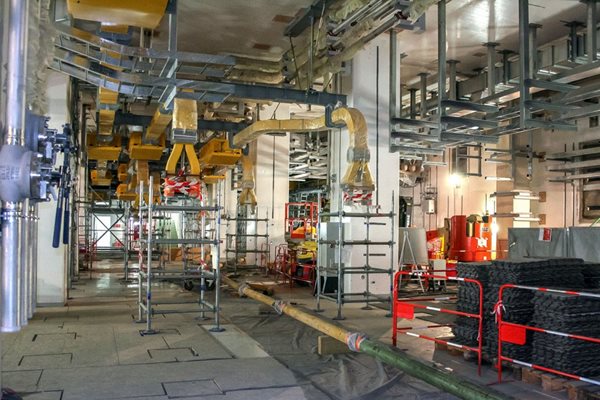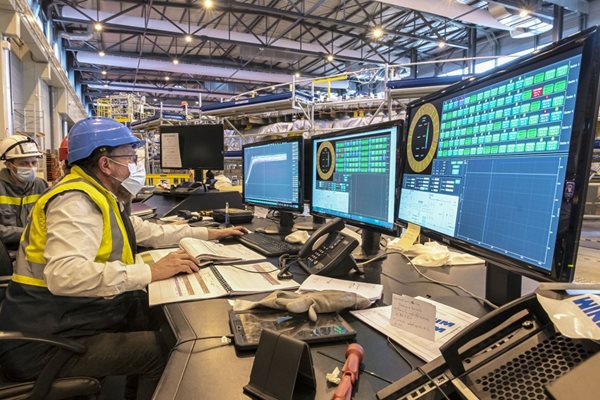
you're currently reading the news digest published from 18 Jan 2021 to 25 Jan 2021
featured3
of-interest1
press12
featured
Neutral beam power | "Outside and beyond anything"
In an empty plot on the ITER platform, preparatory works have started for the construction of two new buildings. From the outside, they will look like ordinary metal-frame structures, clad in ITER's signature mirror-like stainless steel and dark grey-lacquered metal. Inside the largest of the two however, nothing will be quite ordinary. In each of its two, mostly empty halls, Building 37 will accommodate a massive, shiny cube standing like a small house on eight 6-metre high stilts—a 1,000,000-volt high-voltage deck the likes of which does not exist outside the ITER world. These unique devices are the centrepieces of the electrical installation that will feed the ITER neutral beam injection system. Neutral beam injection—the shooting of high-energy ions inside the plasma—is the workhorse of plasma heating techniques and has been implemented in most fusion devices since the mid-1980s. A neutral beam injector uses electrical voltage to accelerate particles to hair-raising speed before 'neutralizing' them in order to penetrate the magnetic cage and communicate their kinetic energy to the plasma. In the European JET tokamak, the system delivers an electrical voltage on the order of 130,000 volts; in the Euro-Japanese JT-60SA, it will reach 500,000 volts for a few minutes; in ITER, it will need to sustain 1,000,000 volts (1MV) for durations of up to one hour. 'This is outside and beyond anything that's ever been done in terms of electrical engineering,' explains Hans Decamps, the technical responsible officer for the ITER neutral beam power supply. 'There are devices in weather research laboratories that generate ultra-high voltage for microseconds in order to modelize lightning, but no one before ITER needed to sustain such high tension for such a long duration.' Faced with a challenge of this magnitude, the ITER Organization and the European Domestic Energy Fusion for Energy, along with Japan and India, began working some ten years ago on a test facility comprising two full-scale mockups for the ITER neutral beam system: SPIDER for the ion source, and MITICA for the full injector including power supply. In October of last year, megavolt power supply components procured by Japan and Europe were successfully tested in MITICA, laying the ground for transposition to the actual installation on the ITER platform. Producing 1MV of direct current (DC) voltage and delivering it to the accelerating plaques inside the injectors requires an array of transformers, generators, rectifiers, inverters and other exotic electrical devices. Part of this equipment will be housed inside the more or less standard Neutral Beam Power Supply Building (Building 34) and in an exterior alley, while the two high-voltage decks*, each dedicated to one injector, will rise like alien structures in the halls of the high voltage building (Building 37). 'Simply stated, each high-voltage installation will be a copy-paste of MITICA,' explains Lionel Lamberlin, the technical responsible officer for auxiliary buildings within the joint Europe-ITER Buildings and Infrastructure and Power Supply (BIPS) Project Team. The nature of these electrical powerhouses has imposed severe constraints on the building's interior design. In order to avoid the generation of electrical arcs, the halls must not present sharp angles or protruding structures. Room temperature, humidity and dust level need to be carefully controlled at all times, and each deck is surrounded by a 5-metre-radius 'exclusion zone.' For obvious safety reasons, no one will be allowed into the building during operation. Nuclear safety also imposes its stringent rules. The equipment itself is not nuclear safety related, but because the largest of the buildings is 25 metres tall and stands relatively close to the Tokamak Building (to which it is connected by bridges and transmission lines), resistance to a potential seismic event, to fire, and to outside explosion determines the building design. 'What we need to prevent above all is the collapse of the building and the 'domino effect' on the protection important components (PIC) in the Tokamak Building,' says Lamberlin. Although the final design for the neutral beam power supply is far from complete, preparatory work has started on the construction site. Karst investigation is done and the digging of temporary excavations is ongoing. Once the upcoming manufacturing readiness review validates a final design, construction by Fusion for Energy contractor Demathieu-Bard will begin in earnest. *ITER is planning two one-million-volt (MV) heating neutral beam injectors (and is making a space reservation for a possible third) as well as a smaller neutral beam line (100 kV) for diagnostic purposes.
Systems installation | Anticipation and flexibility
It is a subterranean world of scaffolding and supports, piping and cables, concrete and embedded plates. To the untrained eye, the activity underway in the basement of the Tokamak Complex can seem overwhelming. But everything is being carried out according to a master plan. The lower levels of the Tokamak Building are buzzing with installation activity—so much, in fact, that it is easy to lose one's bearings from one week to the next. Under the careful supervision of the Tokamak Complex Process Installation Section, approximately 10 percent of the overall installation for complex First Plasma systems has been achieved. The majority of the work has taken place at levels B2 and B2M ('M' for mezzanine) of the Tokamak and Diagnostics buildings. (In the Tritium Building, the bulk of activity is deferred until after the project reaches its First Plasma milestone.) Some 100 workers* are installing cryolines, cooling water lines, cable trays, heating/ventilation/air conditioning (HVAC) equipment, and scaffolding, and making sure all materials required for future installation tasks are available. The installation sequences have been carefully planned. Beginning in the lowest (B2) level of the Tokamak and Diagnostics buildings, contractors are progressing room by room in a counter clockwise manner around the Tokamak pit before moving to the next level (B1). Step by step, task by task, the teams are installing and connecting the systems and equipment needed to feed the machine, with a peak of activity expected in 2022 and 2023. Irremovable busbars and cryolines The Tokamak Complex Process Installation Section faces two major challenges. The first is determining the allocation of space and the installation sequences to follow in order to achieve maximum efficiency—in other words which elements to install where and in what order. The routing of components through the building, and between or through other pre-positioned or installed components such as cryolines and busbars that cannot be modified, is complex and must be carefully considered to avoid potential conflicts. Systems installation is carried out according to a strict plan. The supports go in first, and then typically the HVAC equipment and cable trays are installed near the ceiling. What absolutely must be avoided is installing something and then later having to take it out. In the planning, the teams are constantly superimposing two different pictures—what the room or gallery looks like today, and what it must look like once the construction is over. Taking into account the path of irremovable busbars and cryolines, supports and systems need to be installed at a precise location and welded to embedded plates that have been validated to support the associated load. Anticipating the purpose of each penetration The second challenge is dealing with the 4,600 'penetrations' (or openings) that provide passage for pipes, cables, diagnostics and HVAC between buildings and rooms. In the Tokamak Complex, many are located in crucial areas such as the 1.5-metre-wide outer walls of the Tokamak Building and the 3-metre-wide inner walls surrounding the Tokamak pit that must be filled in for nuclear shielding. The team needs to know exactly what kind of system will be installed inside and on either side of a penetration to design and fill it properly. 'First, you reduce the large openings with concrete backfilling, designed with specific cut-outs for cables, for example, pull them through, then seal the gaps with infilling materials to restore the wall and give it back all its properties in terms of fire protection and sectorization, confinement and radiation shielding,' explains Benjamin Moellinger, coating and corrosion engineer. 'You can't move along with the build and put your systems through until you get the penetration designed and backfilled.' Cryolines, busbars and penetrations are brought into the equation to design the most efficient sequences for the installation of all systems. Still, no matter how much the teams anticipate, they sometimes need to adapt last minute. As a first-of-a-kind project, plenty of adjustments are anticipated throughout the whole build. The Process Installation Section has the processes in place to identify and solve unexpected difficulties in the most efficient manner, always with an eye to not delaying the schedule. For more on plant assembly see these pages of the ITER website. * The Construction Management Office and ITER's Construction Management-as-Agent (CMA), MOMENTUM, coordinate the day-to-day work on the construction platform. For the Tokamak Complex, work has been broken down into three major contracts: TCC0 (early works, now active) and TCC1 and TCC2.
Image of the week | Keeping an eye on the hot (double) pancake
An ITER ring-shaped coil begins its existence as cable-in-conduit conductor, wound into 'double pancakes' that are eventually stacked one upon the other to form the winding pack at the core of the finalized coil. At one point in the fabrication process, each individual double pancake must be resin-impregnated in order to ensure its electrical insulation. The impregnation process is a long and delicate operation: tightly wrapped in insulating fiberglass tape, the double pancake is placed into a leak-tight mould. Several hundred litres of epoxy resin is injected at a temperature of 55-60 °C. As temperature is ramped up and extra pressure applied, the micro spaces inside the winding are filled and the double pancake eventually turns into a massive, rock solid block the colour of burned caramel. Temperature, the quality of the vacuum inside the mould, and the intensity of the injection pressure must be closely monitored at all times. In this image, data fed by approximately one hundred sensors is displayed on large screens and closely examined by the European Domestic Agency (Fusion for Energy) team responsible for the impregnation of the first of eight double pancakes required for poloidal field coil #4 (which will be 24 metres in diameter and weigh 350 tonnes). Three other double pancakes are in various stages of fabrication in the on-site Poloidal Field Coil Winding Facility: one is ready to be impregnated; another is being finalized, and a third is taking shape on the winding table.
of-interest
Register now for the Remote ITER Business Meeting
The detailed program for the ITER Organization's Remote ITER Business Meeting is now available at the following address. Over the two-day remote meeting on 7 - 8 April 2021, experts from the ITER Organization will be presenting information about upcoming contracts and procurement needs including the ITER Hot Cell Complex, the Tritium Plant, and maintenance services, among others. Experts will be also available for one-to-one meetings with industry representatives. The conference is free of charge but advance registration is required. You can register now through 6 April 2021 at this address.



